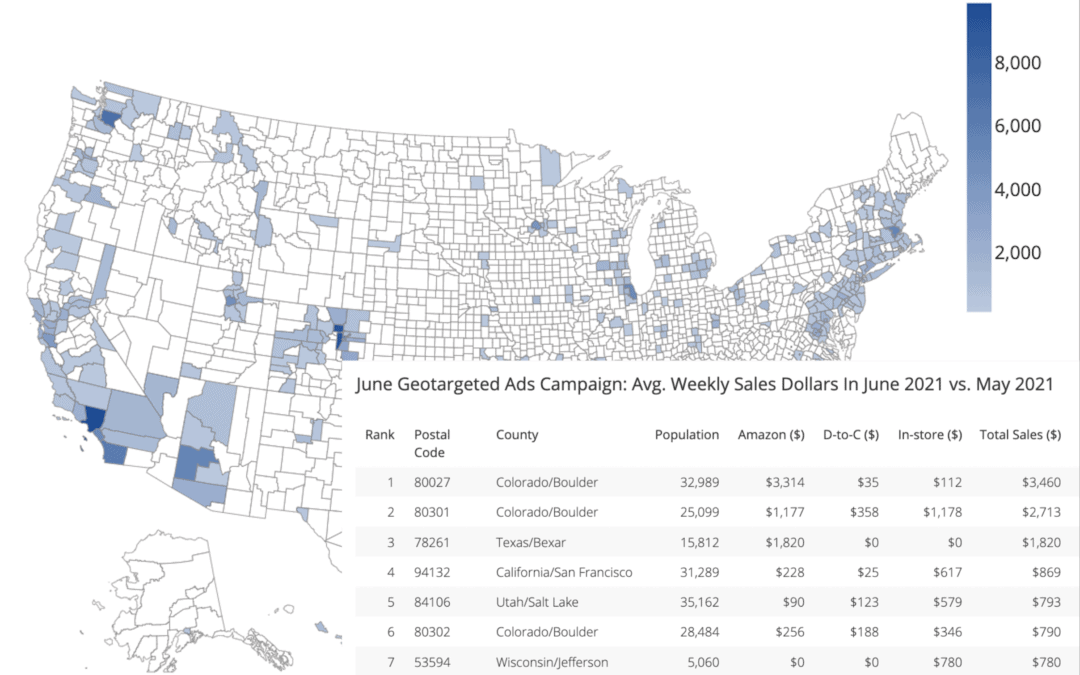Quantifying the sales impact of individual marketing campaigns (ex. in-store promos, online ads, coupons, etc…) is elusive for emerging brands, causing brands to lose sales and waste a lot of money on in-store/online campaigns because they can’t identify the winners from the losers. While the definition of success varies between brands and campaigns, the inability to accurately measure performance at the necessary fidelity is often due to a company not having the time, tools, and experience to analyze the where/when/how impact of a marketing campaign within and across sales channels.
After analyzing both the ecommerce and in-store data for multiple emerging brands, Snowrise has identified a few themes:
1. Each sales channel influences other sales channels. Influences are not consistent across geographies and can be positive or negative.
2. A campaign’s sales impact, especially geotargeted ads, vary considerably within small geographies. Even for a brand’s top selling USA counties, it’s common for 40% of the population to live in postal codes that generate $0 in sales.
3. Seasonality is a location attribute. Seasonality in Miami is not the same as Boston.
4. Every brand is unique, and the same applies to the impact of their marketing campaigns.
In response, Snowrise has launched an analytic service that quantifies the impact a brand’s marketing campaign has across multiple sales channels and geographies down to the postal code. This ability to identify the “what/where/when/how much” upside a marketing campaign has across sales channels truly allows brands to recognize their strengths and optimize future campaigns to grow sales faster with fewer dollars.
Snowrise’s new analytic service combines ecommerce (ex. Amazon, Shopify) and in-store (ex. KeHE, Target, WFM) sales data to:
1. Establish a baseline for where/when/how sales are strong by sales channel and postal code to guide the initial optimization of advertising spend and sales resources.
2. Quantify the impact/influence of in-store and online marketing campaigns in aggregate and by sales channel, retailer, and geography to uncover campaigns that should be terminated or amplified to increase incremental sales.
3. Incorporate campaign costs to identify incremental sales per marketing dollar.
4. Generate and track geographies of interest for campaign trials and broad rollouts, reducing the effort required to develop, share, and maintain campaign performance history.
5. Compare results of different campaigns to optimize campaign methods, timing, and geography, thus highlighting the campaigns that perform the best for the geography and time of year.
6. Maintain a history of past campaign and non-campaign periods for future comparison.
It is not a requirement for the sales data from all sales channels and individual retailers to be included. While more data provides a stronger appreciation into cross-sales channel impacts, insight into what’s happening across a sub-set of ecommerce and in-store retailers is incredibly more valuable than no insight at all. We understand emerging brands face obstacles when trying to obtain sales data for certain distributors/retailers.
If your brand needs to demystify the impact of your marketing campaigns in order to increase sales dollars per marketing dollar spent, please contact us at info@snowrise.net. Snowrise provides full-service sales and marketing analytics across a variety of sales channels.


Recent Comments